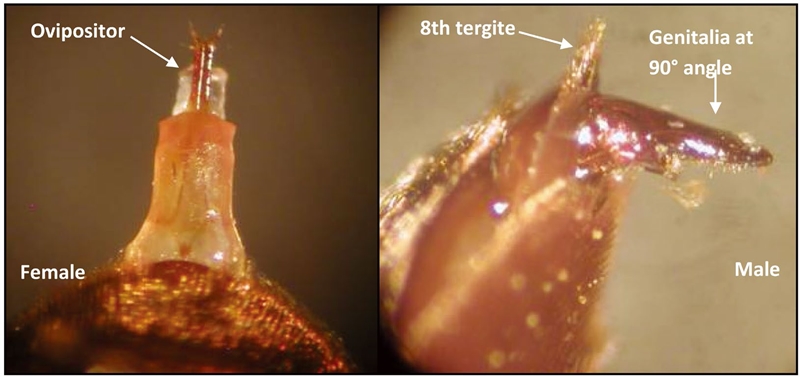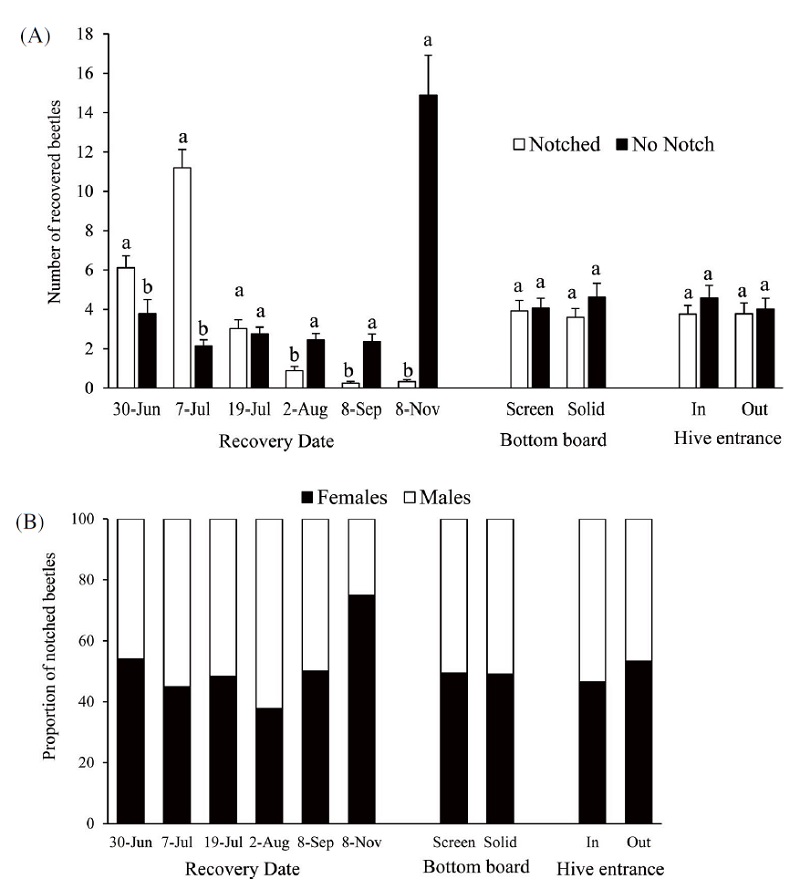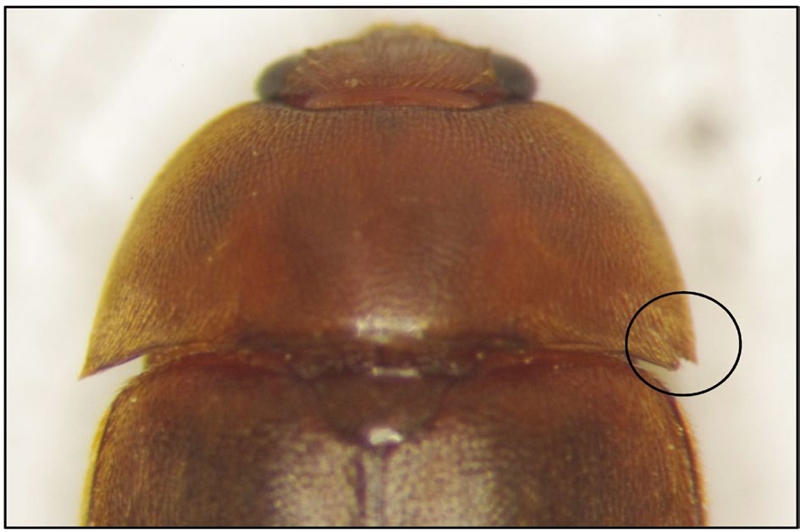
Invasive Success of Small Hive Beetles in Honey Bee Colonies with Screen and Solid Bottom Boards
Abstract
Small hive beetles (SHBs) are invasive pests of Apis mellifera colonies. Within the last five years, SHBs have been detected in Asia, Europe and South America. The high colonization capability of SHB is facilitated by their small size, agility, long survival and ability to conduct long-range dispersal flights. We compared the invasion success of adult SHBs in colonies with screen (8-mesh) or solid bottom boards facing inward or outward of the apiary. Notched beetles were released at the center of an apiary that was devoid of honey bee colonies for about two months and tracked their presence in the colonies for four months. Overall, colonies with screen and solid bottom boards had similar numbers of beetles (~4 notched and 4 no notch). No influence of hive entrance orientation on the number of beetles was also observed. This suggests that the use of screen bottom boards does not promote an increase of SHB population in honey bee colonies since beetles invaded colonies through hive entrances and not through the screen mesh. Thus, screen bottom boards can be used as a component of an Integrated Pest Management program for Varroa mite control.
Keywords:
Small hive beetles, Invasive success, Dispersal, Screen bottom boardSmall hive beetles (SHBs), Aethina tumida, continue to expand their distribution. In Asia, SHBs have been detected in the Philippines in 2014 (Brion, 2015; Cervancia et al., 2016) and in South Korea in 2017 (Lee et al., 2017). In Europe, SHBs have been present in Italy since 2014 (Mutinelli et al., 2014), and first detected in South America (Brazil) in 2015 (Al Toufailia et al., 2017). With this broad expansion, they not only threaten the health of honey bee colonies, but also for non-Apis species around the world (Neumann et al., 2016). In addition to high fecundity, the colonization ability of SHBs is also associated with their long survival, small size, agility and ability to conduct long-range dispersal flights (Spiewok et al., 2008; de Guzman et al., 2012). Adult SHBs survived ~354 days under laboratory conditions (de Guzman et al., 2012). Measuring about 6 mm long and 3 mm wide, the adult beetles can successfully hide in small cracks or crevices (Ellis et al., 2002).
A screen size of 2 mm reduces beetle infestation in honey bee colonies (Ellis et al., 2003). In this study, we compared the invasive success of adult SHBs in colonies equipped with screen and solid bottom boards. We used 8-mesh screen (3 mm), commonly used to regulate Varroa mite population in Apis mellifera colonies, which allows adult SHBs to pass through (Ellis et al., 2003). Colony divisions (n=36) were obtained and placed in a holding apiary. Italian queens were installed because they are known to support high numbers of beetles (Frake et al., 2009). To minimize potential sources of invading SHBs, a test apiary was devoid of honey bee colonies for about two months. By then, developing beetles in the soil would have emerged and infested nearby apiaries. Treatments were randomly assigned into each colony; 18 colonies received screen and 18 had solid bottom boards. All colonies consisted of two medium boxes. All equipment used were in good condition to prevent other entry points for invading beetles aside from the hive entrances. Also, the hive entrances were either facing inward towards the center of the apiary or outward away from the apiary. All inhabiting beetles were removed from each of the colonies before the experiment commenced. Although Italian honey bees are known for their susceptibility to Varroa mites (de Guzman et al., 2007), no chemical treatment was applied to test colonies.
To study the invasive success of SHBs, a mark-release-recapture technique was used. We tracked individual beetles using thoracic notching (de Guzman et al., 2012). Laboratory-reared beetles were used. Beetles were examined individually under a dissecting microscope to determine sex. Females have long ovipositors that extend straight from the tip of the abdomen while the males’ genitalia protrude at a right angle from the ventral surface with the 8th tergite easily viewed dorsally (Fig. 1). Female beetles were notched on the left side of the thorax while males were notched on the right side (Fig. 2). All beetles were starved for one day before use. Two cohorts of beetles consisting of 500 females and 500 males each were released on June 29 and July 6, 2011. The beetles were released at sunset because beetles are active during dusk. During each release, 10 containers with 50 females and 50 males each were placed around the apiary. One day after each release, colonies were inspected to retrieve released beetles. Because beetles normally hide in empty cells and small crevices, individual frames, hive boxes and bottom boards were examined (de Guzman et al., 2006). Empty frames were also bumped on an empty white receptacle. Subsequent collections were conducted on July 19, August 2, September 8 and November 8, 2011. Recovered beetles were examined individually under a dissecting microscope to determine the presence and location of the notch. Recovered beetles were not returned to the test colonies.

Long ovipositor that extends straight from the tip of the abdomen of a female small hive beetle (left) while the males’ genitalia protrude at a right angle from the ventral surface with the 8th tergite easily viewed dorsally (right).
Of the 2,000 beetles released, 136 were unable to fly from the containers. Of the 1,864 that were able to fly, only 42% were recovered from the test colonies within 4 months. The unaccounted beetles may have been in the colonies but were overlooked, and may have attempted to fly, but dropped on the ground or have invaded other colonies in nearby apiaries. Data on the number of beetles recovered through time were subjected to Analysis of Variance for repeated measures using the Proc Mixed procedure (SAS Institute, Inc., 2013). Before analysis, data were transformed using square-root transformation. Our results showed that screen mesh larger than the size of adult beetles did not increase SHB population in the colonies (F=1.78, P=0.183). Overall, colonies with screen and solid bottom boards had comparable number of beetles (~4 notched and 4 without notch). Similarly, no influence of hive entrance orientation was detected (F=0.97, P=0.326) (Fig. 3A). The majority of the notched beetles were recovered from the test colonies one day after their release in June and July. A high number of unmarked (no notch) beetles were collected in November, an indication of an influx of newly emerged beetles during this time. The fecundity of SHBs relies on their ability to mate repeatedly (de Guzman et al., 2012). This can be facilitated by the invasive success of both males and females, which we observed in this study (Fig. 3B). There were nine notched beetles each recovered in September and November, about 2 and 4 months after the release, respectively. This observation confirms SHB’s extended survival in the laboratory (de Guzman et al., 2012). This is the first report on the long survival of both males and females in active colonies. Nineteen colonies succumbed to beetle infestations between September and November. These colonies were weakened by high Varroa mite parasitism. Of the 426 recovered beetles in November, 260 (5 of which were notched) were collected from these dead colonies. Since the test apiary was colony-free for about two months, the collection of unmarked beetles through time may indicate invasion of new cohorts of beetles from nearby colonies or newly emerged beetles from the test apiary. Similarly, the presence of notched beetles during this time may suggest that beetles may have infested nearby colonies first and returned to the test apiary to find new hosts. SHBs may constantly seek colonies to invade.

(A) Number (mean±SE) of notched and no notch small hive beetles recovered from colonies through sampling time. For each date, bars with different letters are significantly different (P<0.05). Number of recovered beetles was not influenced by either bottom board type or orientation of hive entrances (P>0.05). (B) The proportion of notched female and male small hive beetles recovered through time from the same colonies equipped with screen and solid bottom boards facing inward or outward of the apiary.
The use of screen bottom board is thought to encourage SHB invasion due to the unrestricted dissipation of colony volatiles (Ellis et al., 2003). Interestingly, we observed that most of the invading beetles used the hive entrances regardless of bottom board type. The invading beetles behaved much like returning foragers; they hovered in front of the hive, landed on the landing pad and then entered the colony. A few beetles landed on the side of the hive box, but crept in through the hive entrance. There were few beetles observed flying underneath the screen bottom and then disappearing. Thus, it is uncertain whether the beetles successfully entered the hive through the screen or congregated underneath as observed by Ellis et al. (2003). Although the beetles can easily pass through the 8-mesh screen, they seemed hesitant to walk across the screen. While evading being collected, nearly all beetles scurried along the edges of the screen bottom board and not on the screen per se, which may slow down their escape. On the solid bottom, most beetles were also found along the edges, but quickly scattered around during the collection process.
Varroa mites weaken colonies making them vulnerable to SHB infestation. When used by itself, screen bottom board is ineffective for SHB control, but it is helpful in managing Varroa mite population in honey bee colonies (Ellis et al., 2001). When screen bottom boards were used with oil traps, however, some beetles are trapped in the oil minimizing stress on the colonies. Further, heat drives bees to congregate at the hive entrances of colonies equipped with solid bottom boards, which allows opportunistic beetles to feed on everything inside the hive. Also, screened bottom boards provide ventilation for honey bees especially in the Southern region of the United States where it is hot and where SHBs are abundant. This study demonstrates that the use of screen bottom boards, which are commonly used for Varroa mite control, does not promote successful invasion of SHBs in honey colonies and thus, should be used as a component of an Integrated Pest Management program for Varroa mites.
Acknowledgments
T. Stelzer, J. Wales, G. Delatte and Sharon O’Brien provided technical help.
References
-
Al Toufailia, H., D. A. Alves, D. d. C. Bená, J. M. S. Bento, N. S. A. Iwanicki, A. R. Cline, J. D. Ellis and F. L. W. Ratnieks. 2017. First record of small hive beetle, Aethina tumida Murray, in South America. J. Apic. Res. 56: 76-80.
[https://doi.org/10.1080/00218839.2017.1284476]

- Brion, A. C. B. 2015. Small hive betle poses threat to bee industry. The Philippine Star (February 22).
-
Cervancia, C. R., L. I. de Guzman, E. A. Polintan, A. L. B. Dupo and A. A. Locsin. 2016. Current status of small hive beetle infestation in the Philippines. J. Apic. Res. 55: 74-77.
[https://doi.org/10.1080/00218839.2016.1194053]

- de Guzman, L. I., T. E. Rinderer and A. M. Frake. 2007. Growth of Varroa destructor (Acari: Varroidae) populations in Russian honey bee (Hymenoptera: Apidae) colonies. Ann. Entomol. Soc. Am. 100: 187-195.
-
de Guzman, L. I., A. M. Frake and T. E. Rinderer. 2012. Marking small hive beetles with thoracic notching: effects on longevity, flight ability and fecundity. Apidologie 43: 425-431.
[https://doi.org/10.1007/s13592-011-0107-8]

- de Guzman, L. I., T. E. Rinderer, A. M. Frake, H. Tubbs, P. J. Elzen and D. Westervelt. 2006. Some observations on the small hive beetle, Aethina tumida Murray in Russian honey bee colonies. Am. Bee J. 146: 618-620.
- Ellis, J. D., K. S. Delaplane and W. M. Hood. 2002. Small hive beetle (Aethina tumida Murray) weight, gross biometry, and sex proportion at three locations in the southeastern United States. Am. Bee J. 142: 520-522.
-
Ellis, J. D., K. S. Delaplane, R. Hepburn and P. J. Elzen. 2003. Efficacy of modified hive entrances and a bottom screen device for controlling Aethina tumida (Coleoptera: Nitidulidae) infestations in Apis mellifera (Hymenoptera: Apidae) colonies. J. Econ. Entomol. 96: 1647-1652.
[https://doi.org/10.1093/jee/96.6.1647]

- Ellis, J. D. J., K. S. Delaplane and W. M. Hood. 2001. Efficacy of a bottom screen device, Apistan, and Apilife VAR, in controlling Varroa destructor. Am. Bee J. 141: 813-816.
-
Frake, A. M., L. I. de Guzman and T. E. Rinderer. 2009. Comparative resistance of Russian and Italian honey bees (Hymenoptera: Apidae) to small hive beetles (Coleoptera: Nitidulidae). J. Econ. Entomol. 102: 13-19.
[https://doi.org/10.1603/029.102.0103]

-
Lee, S., K.-J. Hong, Y. S. Cho, Y. S. Choi, M.-S. Yoo and S. Lee. 2017. Review of the subgenus Aethina Erichson s. str. (Coleoptera: Nitidulidae: Nitidulinae) in Korea, reporting recent invasion of small hive beetle, Aethina tumida. J. Asia-Pacific Entomol. 20: 553-558.
[https://doi.org/10.1016/j.aspen.2017.03.006]

-
Mutinelli, F., F. Montarsi, G. Federico, A. Granato, A. M. Ponti, G. Grandinetti, N. Ferrè, S. Franco, V. Duquesne, M.-P. Rivière, R. Thiéry, P. Henrikx, M. Ribière-Chabert and M.-P. Chauzat. 2014. Detection of Aethina tumida Murray (Coleoptera: Nitidulidae.) in Italy: outbreaks and early reaction measures. J. Apic. Res. 53: 569-575.
[https://doi.org/10.3896/IBRA.1.53.5.13]

-
Neumann, P., J. S. Pettis and M. O. Schäfer. 2016. Quo vadis Aethina tumida? Biology and control of small hive beetles. Apidologie 47: 427-466.
[https://doi.org/10.1007/s13592-016-0426-x]

- SAS Institute, Inc. 2013. SAS user’s guide v 9.4. SAS Institute, Inc. Cary, NC.
